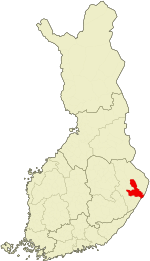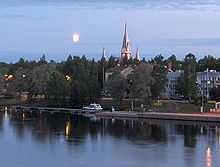Joensuu
| Joensuu | |||
|---|---|---|---|
| City | |||
| Joensuun kaupunki | |||
 | |||
| |||
 | |||
| Coordinates: 62°36′N 029°45′E / 62.600°N 29.750°ECoordinates: 62°36′N 029°45′E / 62.600°N 29.750°E | |||
| Country | Finland | ||
| Region | North Karelia | ||
| Sub-region | Joensuu sub-region | ||
| Charter | 1848 | ||
| Government | |||
| • City manager | Kari Karjalainen | ||
| Area(2011-01-01)[1] | |||
| • Total | 2,751.07 km2 (1,062.19 sq mi) | ||
| • Land | 2,381.76 km2 (919.60 sq mi) | ||
| • Water | 369.31 km2 (142.59 sq mi) | ||
| Area rank | 24th largest in Finland | ||
| Population (2013-08-31)[2] | |||
| • Total | 74,192 | ||
| • Rank | 12th largest in Finland | ||
| • Density | 31.15/km2 (80.7/sq mi) | ||
| Population by native language[3] | |||
| • Finnish | 97.4% (official) | ||
| • Swedish | 0.1% | ||
| • Others | 2.5% | ||
| Population by age[4] | |||
| • 0 to 14 | 15.3% | ||
| • 15 to 64 | 68.5% | ||
| • 65 or older | 16.2% | ||
| Time zone | EET (UTC+2) | ||
| • Summer (DST) | EEST (UTC+3) | ||
| Municipal tax rate[5] | 19.5% | ||
| Unemployment rate | 14.5% | ||
| Website | www.jns.fi | ||
Joensuu (lit. "mouth of the river") is a city and municipality in North Karelia in eastern Finland. It is located in the province of Eastern Finland and is part of North Karelia region. It was founded in 1848. The population of Joensuu is 74,192 (August 31, 2013),[1] though the economic region of Joensuu has a population of 115,000.[6]
Joensuu is a lively student city with over 15,000 students enrolled at the University of Eastern Finland and a further 4,000 at the North Karelia University of Applied Sciences.[7]
The largest employers are the municipal City of Joensuu, North Karelian Hospital District Federation of Municipalities, Abloy and Punamusta.
The European Forest Institute, the University and many other institutes and export enterprises such as Abloy and John Deere Forestry give Joensuu an international flavour.
History
The city of Joensuu, which was founded by the Czar Nicholas I of Russia in 1848, is the regional centre and the capital of North Karelia. During the 19th century Joensuu was a city of manufacture and commerce. When in 1860 the city received dispensation rights to initiate commerce, former restrictions against industry were removed and the local sawmills began to prosper and expand. Water traffic was improved by the building of the Saimaa Canal. Consequently, a lively commerce between the regions of North Karelia, St.Petersburg and Central Europe was enabled. At the end of the 19th century Joensuu was one of the largest harbour cities in Finland.
Throughout the centuries Karelian traders have plied the Pielisjoki River. The river has always been the lively heart of the city. Canals – completed by 1870 – increased the river traffic. Thousands of steamboats, barges and logging boats sailed along the river during the golden age of river traffic. The Pielisjoki River has also been an important log raft route, providing wood for the sawmills and for the entire lumber industry.
During the last few decades, the formerly modest agrarian town has developed into a vital center of the province. Success in regional annexations, the establishment of the province of Karelia and investments in education have been the most decisive actions in this development.
Municipality of Pielisensuu was consolidated with Joensuu in 1954. At the beginning of 2005, the municipalities of Kiihtelysvaara and Tuupovaara were consolidated with Joensuu. At the beginning of 2009 the municipalities of Eno and Pyhäselkä were consolidated with Joensuu. After the most recent consolidations, there are approximately 73,000 inhabitants in the Joensuu municipal area.

The University of Joensuu has, in twenty-five years, expanded to eight faculties. The University of Joensuu is one of the mainstays for the vitality of the city and so for all North Karelia. Diversified international cooperation in science, industry and commerce benefits the whole region.
The proximity of the eastern border has been an important factor in the history of the city. The Republic of Karelia is once again a significant area for cooperation with nearby regions in Russia. Export companies in Joensuu continue the pre-revolutionary traditions in foreign trade.
Joensuu offers varied cultural activities. A series of events – Ilosaarirock festival, Joensuu Music Winter, Festival of Visual Culture Viscult, Gospel festivals – and the unspoilt environment increase the attractiveness of the city.
Joensuu is sometimes referred to as the Forest Capital of Europe, mainly due to the fact that the European Forest Institute is based there. Other forestry research and educational facilities are also based in Joensuu.
Statistics
- Nearest airport with regular air service: Joensuu Airport, Liperi, 11 km
- Nearest inland port: Joensuu
- Districts: 26
Transport


Distances to other Finnish cities:
| City | Distance | Direction |
|---|---|---|
| Helsinki | 437 km | SW |
| Jyväskylä | 245 km | W |
| Kuopio | 136 km | NW |
| Lappeenranta | 235 km | SW |
| Oulu | 393 km | NW |
| Kajaani | 222 km | NW |
| Savonlinna | 133 km | SW |
| Tampere | 393 km | SW |
| Turku | 542 km | SW |
| Vaasa | 492 km | W |
Joensuu has a railway station and a bus station, which offers intercity connections to Helsinki and local connections to several other places. Numbered bus service is available to all parts of Joensuu(Route maps, Timetables). Note, that if you want to catch a bus, you have to wave at the driver - the bus does not stop automatically. Joensuu also has an airport, with flights to Helsinki.
Sports

The city is known for its basketball club Kataja, which plays in the Finnish first-tier league Korisliiga. Other championship level clubs of Joensuu include Josba (floorball), Mutalan Riento (volleyball), the world leading orienteeringclubKalevan Rasti (orienteering) and Joensuun Prihat (women's volleyball). The ice hockey team Jokipojat plays in the Finnish second-tier league Mestis, and their home arena is the Mehtimäki Ice Hall. The local football club Jippo plays in the Finnish First Division. Finnish baseball enjoys popularity as well and the local team, Joensuun Maila, plays in the top division Superpesis.
Joensuu has produced many world class athletes, including Jukka Keskisalo, the European champion in 2006 at 3000m St., and Aki Parviainen, the world champion of Javelin throw in 1999.
Joensuu is home to biathlete Kaisa Mäkäräinen, who won the overall World Cup title in the 2010-11 Biathlon World Cup season.
Friendship cities
-
 Linköping, Sweden
Linköping, Sweden -
 Ísafjarðarbær, Iceland
Ísafjarðarbær, Iceland -
 Tønsberg, Norway
Tønsberg, Norway -
 Petrozavodsk, Russia
Petrozavodsk, Russia -
 Sortavala, Russia
Sortavala, Russia -
 Suoyarvi, Russia
Suoyarvi, Russia -
 Hof, Germany
Hof, Germany -
 Vilnius, Lithuania
Vilnius, Lithuania
References
- ↑ 1.0 1.1 "Area by municipality as of 1 January 2011" (PDF) (in Finnish and Swedish). Land Survey of Finland. Retrieved 9 March 2011.
- ↑ "VÄESTÖTIETOJÄRJESTELMÄ REKISTERITILANNE 31.8.2013" (in Finnish and Swedish). Population Register Center of Finland. Retrieved 15 September 2013.
- ↑ "Population according to language and the number of foreigners and land area km2 by area as of 31 December 2008". Statistics Finland's PX-Web databases. Statistics Finland. Retrieved 29 March 2009.
- ↑ "Population according to age and gender by area as of 31 December 2008". Statistics Finland's PX-Web databases. Statistics Finland. Retrieved 28 April 2009.
- ↑ "List of municipal and parish tax rates in 2011". Tax Administration of Finland. 29 November 2010. Retrieved 13 March 2011.
- ↑ "City of Joensuu". Welcoming Guide. North Karelia University of Applied Sciences. Retrieved 12 February 2013.
- ↑ http://www.pkamk.fi/english/default.htm
External links
| Wikimedia Commons has media related to Joensuu. |
- Joensuu Marketplace webcam
- City of Joensuu (English)
- City of Joensuu (Finnish)
- Pielis.ru – Travel information about North Karelia region and City of Joensuu
-
 Joensuu travel guide from Wikivoyage
Joensuu travel guide from Wikivoyage

